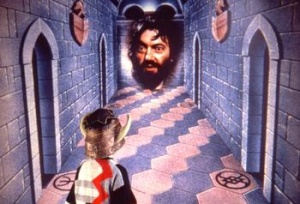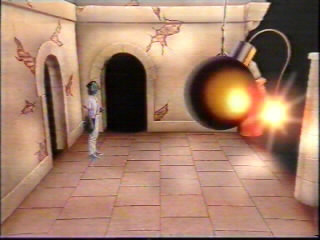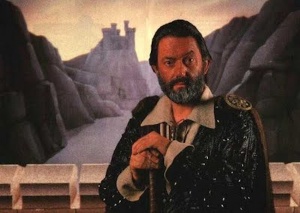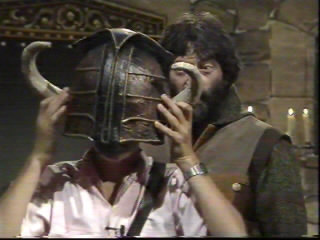Weaver's Week 2013-05-12
Last week | Weaver's Week Index | Next week
Welcome to the off-season, those weeks of summer when there's no University Challenge, no Mastermind, no Only Connect.
This week, we had planned to continue our occasional series on DIY media. Plans changed when we attended Slingshot's 2.8 Hours Later Asylum: it's an enjoyable way of spending the evening, but it's sufficiently close to the 2011 show that we can't give it a fresh review.
Then we learned that the Challenge channel was going to start repeating Knightmare. And we looked back and found that we'd never written anything substantial about Knightmare, and that lots of other people had. A quick tour of the fan sites reveals more quality writing than this column's ever written, and we can but scratch the surface of:
DIY Media: Knightmare
What was Knightmare? A long-running programme on Children's ITV, running from 1987 to 1994. Teams of four – one dungeoneer and three advisers – would go on a quest to retrieve a sacred object. On this journey, they would meet various characters, undertake challenges and endure tests of wits and skill. The iconic prop was the helmet worn by the dungeoneer, which covered the eyes so that they could not see ahead of them.
This helmet was one nod to the practicalities of making the show. Rather than actually filming on location in a castle, or in some sewers, or on a dragon's back, everything was shot in front of a coloured background. Chromakey magic then filled in the background: initially atmospheric and slightly abstract paintings, latterly more photo-realistic depictions. The dungeoneer did interact with real people, actors who were permitted and encouraged to improvise their lines while heading towards a precise conclusion.
Each quest was divided into three levels, prosaically called Levels One, Two and Three. Here's another practical point: everything the team needs to complete Level One is on that level, they will carry nothing forward into Level Two. It allowed the scripts to be written completely independently of each other: the team could go from module 1g to module 2b. Or not, if they were rubbish.
Over at Knightmare.com, James Aukett has written up his recollections of the show, and how it changed from series to series. The oft-remembered hexagonal causeways didn't appear until series five, and the iconic corridor of chainsaws made its debut in series four. While viewers increased in age, the target audience for Knightmare seemed to go in the opposite direction: this column looked at the first series and found it too complicated for our tastes, with dungeon-master Treguard an overseer, someone to move along the plot rather than help the team. There wasn't an obvious baddie, and no prize beyond winning "squiredom". By the time we had time to watch Knightmare properly, it was too juvenile for us, all hissing fish and a jumping jester called Pickle.

The disembodied head of Treguard watches like the Teletubbies sun.
We didn't get it, but a lot of people did. There was a semi-official fan club, the Knightmare Adventurer's Club, which survived the series by a year. Fans wrote and distributed a printed fanzine, The Eye Shield, for a couple of years longer, and it was revived in 2001 as an internet-only publication, lasting a further ten years. The fandom was able to produce a well-written, literate, and intelligent read for very nearly twice as long as the series on which it was based. Well done, everybody.
In turn, The Eye Shield spawned an audio series, a group of new audio dramas set in the world of Knightmare. Again, these are of high quality (or we've been very lucky in our random choices), and while we don't quite understand all the references back to the original programme, we do understand enough that they make sense. More recently, the Knightmare Audio Repertory Company has undertaken some scripted quests; the dungeoneers and advisors are played by members of the cast. We've heard the most recent episode, a "Christmas special" released last December, though the seasonality is limited to a few references on Level One. About the only constructive criticism we have is that we'd have liked to hear the cast credited at the end of the show. It would be interesting if these creative types were to pit their wits against unprepared fans in some sort of real-life challenge match.
 Tick! Tick! Tick! Tick! Boom!
Tick! Tick! Tick! Tick! Boom!A pedant writes: No! The bomb rooms were finished by 1989, and you're using a cultural reference from 1993.
Spellcasting: S-H-U-T-U-P.
In a piece published just last weekend, Chris Ballard argues that Knightmare couldn't now be made as a children's show. CITV was effectively disbanded a decade ago, the BBC no longer produces any television at the 12-16 age group, and so on. He suggests a family show, in the merchandise-driven mode of Doctor Who, or the mass appeal of an incredible challenge like The Cube. Other writers have suggested exploiting a slot around midnight, an idea we're less fond of, because we'll be fast asleep.
The problem faced by any revival is that viewers have memories. Any revival will invite comparisons to the original, and the revival has to work twice as hard to succeed. Catchphrase and Saturday Night Takeaway have done reasonably well, but they're comfort food, not must-see television. By comparison, CITV's Fort Boyard revival has worked, in part because the target audience has no memory of Channel 5's efforts and don't need to know that it's The Crystal Maze reskinned. "The only way is forward, you cannot go back," was Treguard's commandment to all dungeoneers. We fear that it applies to television.
But if Knightmare were to come back, it would face a different problem: CGI animation has got better. Back in 2004, Televirtual made "Knightmare VR", a 13-minute proof-of-concept video demonstrating how a virtual reality show might work. Rather than show action with the adventurer wearing a helmet, show action with them actually in the scene. Chris Ballard argues that Knightmare VR fell into the "uncanny valley", animation that looks reasonably realistic, but has enough flaws to be obviously not real. It's the problem this column has with much modern-day animation: we like Wile E. Coyote to be a slip of paper slapped on a crude drawing of the Arizona desert. We don't like him to always cast shadows in a distinct coyote shape (with Road Runner cut-out, natch).
The "uncanny valley" is not a problem that affects the audio productions, of course. Here, a brief description of the room suffices. ("Where am I?" "You're in a stone-clad room, and here's a lady in a floating green dress.") Visual puzzles like the causeway don't work, of course, but we can accommodate a brief scene where the dungeoneer's under attack from fireballs. Maybe less is more, and a suitable backdrop could be projected into a near-empty studio where the player was: see any recent Eurovision Song Contest stage.
What of Knightmare's influence on subsequent television? We could suggest that some of the moral ambiguity and the atmosphere went to The Crystal Maze (1990-95). Raven (2002-10) clearly owed a massive debt to Knightmare: tests on a quest, sometimes of skill and dexterity, with an increasing role for an arch-nemesis. Remote control of a player who can't see by people who can was only a small part of Knightmare, and that had antecedents back to The Adventure Game (1980-86). But then there are little things, the way Knightmare made spelling compelling (Hard Spell, 2004-6), the "Adventure Call" series of spoofs on Limmy's Show! (BBC Scotland, since 2010), and the way it encouraged participation, the prize was the quest, not money or a holiday (My Little Princess, 2013, where the reward for victory was one evening out.)
And there's more. Much more. We've not touched on the world of fan fiction, the world where Treguard and Fear meet and clash. We've not investigated loose spin-offs in other media, the inter-relationship between Knightmare and role playing games and Jackson and Livingstone's Fighting Fantasy. And as editor Mr. Bodycombe noted on this week's Fifty 50 Show, the debt Knightmare owes to the ZX Spectrum game Atic Atac, with its castle setting and life force. Or looser spin-offs, like the nascent Aegis Quest project from a few years ago. We've barely had a chance to view James Aukett's half-hour documentary, where he interviews crew, cast, and contenders.
The show may be over; the creative work goes on.
This Week And Next
BBC4 controller Richard Klein-Bottle is to move to ITV. The only television executive to be named after a topological joke will head ITV's factual unit. His skill at turning very small audiences into surprisingly big ones by making quality programmes will be tested to the max.
BARB ratings for the week to 28 April. Britain's Got Talent has a huge lead over The Voice in overnights, but it's whittled away almost to nothing by the final score – 9.15m to 9.05m this week. Masterchef continued with 6m viewers, HIGNFY pulled in 5.35m, and there are 4.4m for Catchphrase. On BBC2, The Great British Sewing Bee had 3.1m in stitches, with 2.9m seeing the University Challenge semi-final.
Elsewhere, Celebrity Juice pulled 1.965m to ITV2, the Sunday repeat of The Voice brought 1.015m to BBC3, and Deal or No Deal had 960,000 Channel 4 viewers. Yes, the Fourth Programme's biggest game show is beaten by two from non-traditional channels. Britain's Got More Talent had 715,000 viewers, and Mock the Week on Dave 395,000. The Challenge channel had 245,000 seeing vintage Bullseye on Sunday evening, the channel's highest viewership for proper game shows (as distinct from wrestling) this year.
It's Eurovision Song Contest season! Greg James and Russell Kane investigate How to Win Eurovision (BBC3, 8pm Wed), ahead of the semi-finals (BBC3 and RTE2, 8pm Tue and Thu) and final (BBC1, RTE1, BBC Radio 2, RTE Radio 1, 8pm Sat). But if that's not your cup of tea, Sunday night has something for all tastes: The Write Stuff (Radio 4, 7.15), Celebrity Deal or No Deal with The Jls (C4, 8pm), and the British Academy Television Awards (BBC1, 8pm). New titles, new graphics, new tournament structure, a new host's caption. The return of Only Connect (BBC4, 8.30 Mon) means one thing: the off-season ends here.
To have Weaver's Week emailed to you on publication day, receive our exclusive TV roundup of the game shows in the week ahead, and chat to other ukgameshows.com readers, sign up to our Yahoo! Group.




